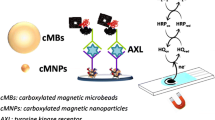Abstract
A highly sensitive amperometric magnetoimmunoassay for rapid determination of lipoprotein(a) (Lp(a)), an important predictor of cardiovascular disease risk, in human serum, is described. It uses a sandwich configuration involving selective capture antibody [antiLp(a)] and biotinylated detector antibody [biotin-antiLp(a)], and a streptavidin-HRP conjugate on carboxy-modified magnetic beads (HOOC-MBs). The resulting MBs bearing the sandwiched immunoconjugates were captured by a magnet placed under the working electrode surface of a disposable screen-printed carbon electrode and the extent of the affinity reaction was monitored amperometrically at −0.20 V (vs a silver pseudo-reference electrode) in the presence of hydroquinone as an electron transfer mediator and upon addition of H2O2 as the enzyme substrate. The method exhibited a wide linear response range (from 0.01 to 0.5 μg mL−1), a detection limit of 4 ng mL−1, and an excellent selectivity over other serum components. The utility of the immunoassay was demonstrated by analyzing a reference serum containing a certified quantity of Lp(a). The performance of this magnetoimmunoassay compares favorably to that of an integrated amperometric immunoassay described earlier.

The article describes the first disposable and highly sensitive amperometric magnetoimmunoassay for lipoprotein(a), an important predictor of cardiovascular disease risk, in human serum. It is based on a sandwich configuration involving selective capture antibody and biotinylated secondary antibody, and a streptavidin-HRP conjugate on magnetic beads.



Similar content being viewed by others
References
Bone K, Mills S (2013) Principles and practice of Phytotherapy: modern herbal medicine. 2nd edn. Churchill Livingstone Elsevier. In p. 229.
Danesh J, Erqou S (2009) Lipoprotein(a) and coronary disease-moving closer to causality. Nat Rev Cardiol 6(9):565–567
Clarke R, Peden JF, Hopewell JC et al (2009) Genetic variants associated with Lp(a) lipoprotein level and coronary disease. N Engl J Med 361(26):2518–2528
Missala I, Kassner U, Steinhagen-Thiessen E (2012) A systematic literature review of the association of lipoprotein(a) and autoimmune diseases and atherosclerosis. Int J Rheumatol 2012:480784
Byrne DJ, Jagropp IA, Montgomery HE, Thomas M, Mikhailidis DP, Milton NG, Winder AF (2002) Lipoprotein(a) does not participate in the early acute phase response to training to extreme physical activity and is unlikely to enhance any associated immediate cardiovascular risk. J Clin Pathol 55(4):280–285
Kamstrup PR, Tybjærg-Hansen A, Nordestgaard BG (2013) Extreme lipoprotein(a) levels and improved cardiovascular risk prediction. J Am Coll Cardiol 61(11):1146–1156
Cooper GR, Wilson PWF, Myers GL, Grundy SM, Labarthe DR (2009) Lipoprotein(a) and cardiovascular disease risk. In Laboratory Medicine Practice Guidelines: Emerging Biomarkers for Primary Prevention of Cardiovascular Disease and Stroke. Myers GL Editor. The American Association for Clinical Chemistry, Inc. Chapter 5.
Alonso R, Andres E, Mata N, Fuentes-Jiménez F, Badimón L, López-Miranda J, Padró T, Muñiz O, Díaz-Díaz JL, Mauri M, Ordovás JM, Mata P (2014) Lipoprotein(a) levels in familial hypercholesterolemia: an important predictor of cardiovascular disease independent of the type of LDL receptor mutation. J Am Coll Cardiol 63(19):1982–1989
Kostner GM, Ibovnik A, Holzer H, Grillhofer H (1999) Preparation of a stable fresh frozen primary lipprotein(a) (Lp(a)) standard. J Lipid Res 40(12):2255–2263
Sorell L, Rojas G, Rodríguez M, Ramos C, Torres L, Torres MB (1995) A sandwich ELISA based on anti-apo(a) and anti-apo B monoclonal antibodies for lipoprotein(a) measurement. Clin Chim Acta 236:59–70
Baldo-Enzi G, Baiocchi MR, Crepaldi G (1993) Comparison of lipoprotein(a) assay methods in serum and in a plasminogen-free fraction. Clin Chim Acta 218:83–95
Wang JJ, Zhaung YY, Yao XD (1997) Quantitation of plasminogen epitopes of serum lipoprotein(a) by sandwich enzyme linked immunosorbent assay. Clin Chim Acta 265:121–130
Wang J, Qiang H, Zhang C, Liu X, Chen D, Wang S (2003) Detection of IgG-bound lipoprotein(a) immune complexes in patients with coronary heart disease. Clin Chim Acta 327:115–122
Wang J, Zhang C, Gong J, Zhu Y, Fu L, Wang X, Li K (2007) Development of new enzyme-linked immunosorbent assay for oxidized lipoprotein(a) by using purified human oxidized lipoprotein(a) autoantibodies as capture antibody. Clin Chim Acta 385:73–78
Esteban-Fernández de Ávila B, Campuzano S, Pedrero M, Salvador JP, Marco MP, Pingarrón JM (2014) Lipoprotein(a) determination in human serum using a nitrilotriacetic acid derivative immunosensing scaffold on disposable electrodes. Anal Bioanal Chem 406:5379–5387
Conzuelo F, Gamella M, Campuzano S, Reviejo AJ, Pingarrón JM (2012) Disposable amperometric magneto-immunosensor for direct detection of tetracyclines antibiotics residues in milk. Anal Chim Acta 737:29–36
Gamella M, Campuzano S, Conzuelo F, Reviejo AJ, Pingarrón JM (2012) Amperometric magnetoimmunosensors for direct determination of D-dimer in human serum. Electroanalysis 24(12):2235–2243
Esteban-Fernández de Ávila B, Escamilla-Gómez V, Campuzano S, Pedrero M, Salvador JP, Marco MP, Pingarrón JM (2013) Ultrasensitive amperometric magnetoimmunosensor for human C-reactive protein quantification in serum. Sens Actuat B-Chem 188:212–220
Loaiza OA, Campuzano S, Pedrero M, Pividori MI, García P, Pingarrón JM (2008) Disposable magnetic DNA sensors for the determination at the attomolar level of a specific Enterobacteriaceae family gene. Anal Chem 80:8239–8245
Esteban-Fernández de Ávila B, Escamilla-Gómez V, Campuzano S, Pedrero M, Pingarrón JM (2013) Disposable amperometric magnetoimmunosensor for the sensitive detection of the cardiac biomarker amino-terminal pro-B-type natriuretic peptide in human serum. Anal Chim Acta 784:18–24
Acknowledgments
The financial support of the Spanish Ministerio de Economía y Competitividad Research Projects, CTQ2012-34238, and the NANOAVANSENS Program from the Comunidad de Madrid (S2013/MT-3029) are gratefully acknowledged. R. M. Torrente-Rodríguez acknowledges a CPFD predoctoral contract from the Spanish Ministerio de Economía y Competitividad. The authors would also like to acknowledge Audit Diagnostics Company for kindly providing the Lp(a) and its specific antibodies and M. P. Marco Research Group for the preparation of the biotin-anti Lp(a).
Author information
Authors and Affiliations
Corresponding authors
Rights and permissions
About this article
Cite this article
Kaçar, C., Torrente-Rodríguez, R.M., Pedrero, M. et al. Amperometric magnetoimmunoassay for the determination of lipoprotein(a). Microchim Acta 182, 1457–1464 (2015). https://doi.org/10.1007/s00604-015-1472-1
Received:
Accepted:
Published:
Issue Date:
DOI: https://doi.org/10.1007/s00604-015-1472-1




